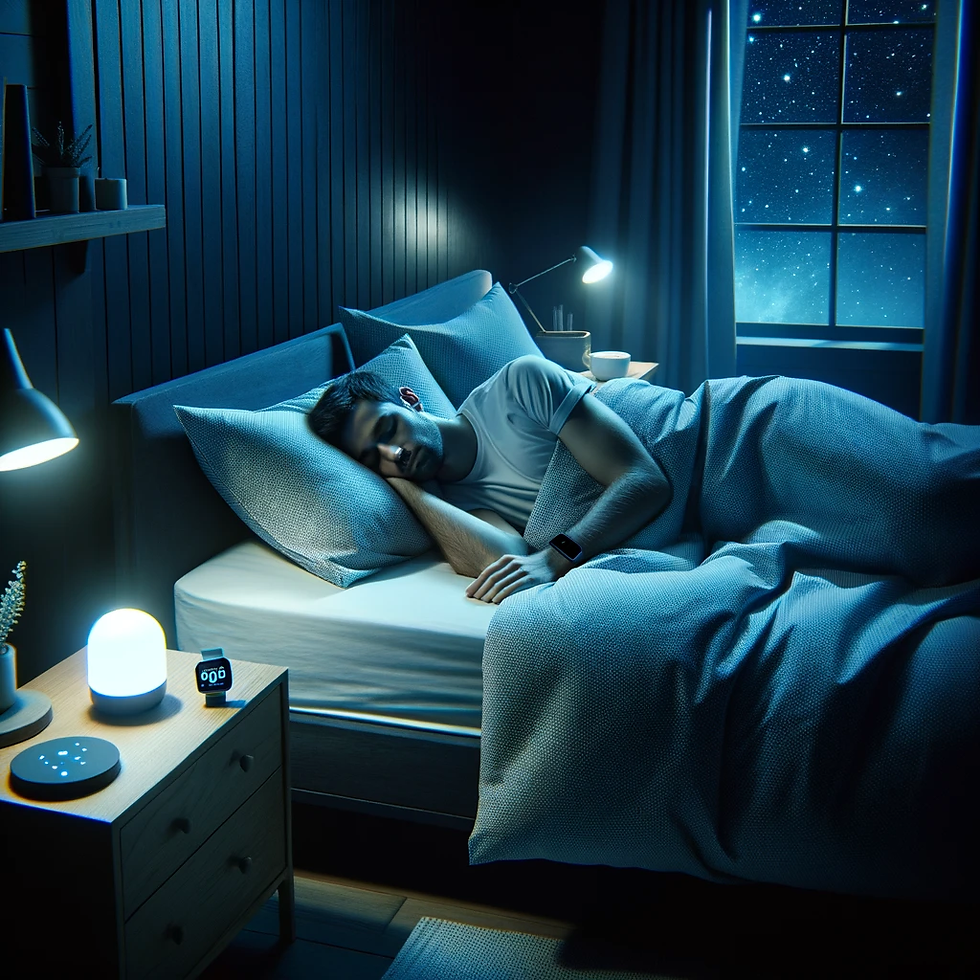Near-Infrared light could be the "magic pill" for sleep
- Nov 4
- 6 min read
Credit: Dr. Brian Grimm • | Field Biology Exploring light, charge, mitochondria, and meaning. Weekly posts that decode hidden signals in your health. Subscribe: drgrimmmd.substack.com
The Invisible Half of Medicine
Near Infrared Deficiency Syndrome, or NIRDS, describes a core problem in modern biology: our cells are starving for the wavelengths of light that drive repair.
The near infrared spectrum between 700 and 1400 nanometers powers mitochondrial function and helps the body maintain internal order. Most environments today are lit by artificial sources that emit heavy blue light and very little near infrared. Ultraviolet light helps set our timing through circadian rhythm. Near infrared light restores charge, coherence, and repair. The balance between those two ends of the spectrum once kept our biology synchronized.
When the body loses consistent exposure to near infrared, it loses part of the energy code that keeps cells efficient. The result is reduced mitochondrial function, slower recovery, and impaired neurological performance.
Sleep cannot reach its full restorative potential without that wavelength.

The Biophysics of Sleep and Repair
Sleep rebuilds the brain. Deep and REM stages restore electrical balance, clear waste, and prepare neurons for learning and memory. These processes depend on mitochondria (the energy centers inside each cell) being able to create ATP and maintain redox stability.
Near infrared light activates an enzyme inside the mitochondria called cytochrome c oxidase. This improves oxygen binding and electron flow, leading to higher ATP production and balanced nitric oxide signaling. When that activation signal is missing, the mitochondria lose efficiency.
As efficiency declines, the surrounding water structure thins, proteins begin to misfold, and inflammation increases. The brain experiences reduced clarity, slower recovery, and chronic fatigue.
Mitochondrial charge is the foundation of mental sharpness. Sleep depends on it.

The Human Spectrum of Light
Human vision detects wavelengths between about 400 and 700 nanometers. That range covers violet to deep red. Just beyond visible red begins near infrared—light that is invisible to the eye but deeply active in tissue.
In sunlight, roughly forty percent of the total energy reaching the surface of the Earth is near infrared. It penetrates skin several centimeters deep, energizing blood vessels, nerves, and even bone. Firelight, sunlight, and body heat have always surrounded us with this form of energy.
Near infrared was constant in the natural environments where human biology evolved. Morning and evening light provided low-angle infrared exposure that prepared the body for rest and repair. Removing those wavelengths from our daily lives leaves the nervous system without the environmental signal that stabilizes it.
The result is loss of coherence between energy, structure, and rhythm.

Light and the Brain
Light influences the nervous system through more than vision. It acts on the eyes, skin, blood, and cerebrospinal fluid.
Blue light around 460 to 480 nanometers activates melanopsin and sets the body’s internal clock. Near infrared penetrates the skull and stimulates mitochondrial repair, increasing ATP and stabilizing nitric oxide. Evening infrared supports melatonin release and promotes the transition from activity to rest.
Infrared exposure also enhances parasympathetic tone through the vagus nerve, lowering stress hormones and supporting deep sleep. Efficient mitochondria enable the brain’s glymphatic system to clear waste overnight.
When the body receives the full spectrum, sleep architecture stabilizes. Deep and REM cycles lengthen, and neurological repair becomes more complete.
The reverse, excessive blue-light, actually reduces melatonin production. In saliva studies, melatonin was reduced most with exposure to the exact wavelength of blue-light.

Patterns of NIRDS
Dr. Brian Grimm’s research outlines how near infrared deficiency appears across different clinical conditions.
Neurodegenerative disease reflects loss of redox balance in the brain.
Diabetes and metabolic dysfunction stem from impaired mitochondrial repair.
Cardiovascular disease involves endothelial damage and oxidative stress.
Chronic pain and neuropathy develop from nerve mitochondrial breakdown.
Macular degeneration and glaucoma originate in retinal energy loss.
Sleep disorders result from disrupted circadian and melatonin coupling.
Poor wound healing, fibromyalgia, and fatigue indicate regenerative failure.
Cancer progression involves loss of bioenergetic control.
Each condition represents the same breakdown: the loss of coherence between energy and structure.
In the nervous system, that breakdown produces slower thinking, weaker memory, and emotional instability. Neurons fall out of rhythm, and the energy cost of thought increases.

Credit: Dr. Brian Grimm
Why Light Determines Sleep Quality
Sleep is an active process of charge redistribution and tissue reconstruction. The mitochondria manage that process by controlling the flow of energy through every cell.
When mitochondrial efficiency drops, the system cannot fully restore itself. The result is poor REM consolidation, reduced emotional regulation, and waking fatigue.
Many people experience exhaustion even with adequate sleep. The cause often lies in the cell’s inability to recharge its internal battery. Sleep quantity does not equal sleep quality when the light environment prevents recovery.

Restoring the Missing Spectrum
Natural light exposure remains the most effective way to reverse NIRDS.
Morning sunlight. Step outside within ten minutes of waking. Sunlight provides the complete spectrum, including infrared, and sets circadian rhythm for the day.
Evening firelight or infrared. Replace harsh white lighting with warm light sources. A candle, fireplace, or infrared bulb creates a field of light that signals repair.
Heat therapy. Saunas and body heat reproduce the thermal and infrared environment of early humans, promoting mitochondrial biogenesis and parasympathetic recovery.
Outdoor activity. Physical movement under natural light synchronizes metabolism, oxygen use, and energy flow.
Sleep environment. Remove LEDs and bright screens from the bedroom. Use darkness and warmth to teach the body that night is time for restoration.
Clinical integration. Combining light exposure with nutrition, circadian scheduling, and relaxation techniques accelerates neuro recovery for patients with fatigue, TBI, or PTSD.

Military and Operational Readiness
Special operations and high-demand professions operate under chronic sleep restriction. The environments are filled with artificial light and constant stress. Under these conditions, the body spends energy faster than it can repair.
When teams live in light-deprived environments, near infrared exposure becomes almost nonexistent. Over time this erodes resilience, impairs cognition, and slows physical recovery.
The symptoms seen in many veterans—insomnia, depression, fatigue, and reduced mental clarity—reflect mitochondrial incoherence.
Restoring near infrared exposure is not a comfort measure. It is a readiness protocol. Full spectrum light can be built into recovery areas, training facilities, and even field units. Firelight, sunlight, or controlled infrared exposure after missions can help maintain neural balance and reduce fatigue.

Photonic Medicine and the Future of Sleep
Light organizes life. Every biological system, from plants to human cells, relies on photons to direct energy flow and maintain structure.
The mitochondria are the interface between light and metabolism. When they absorb near infrared energy, they regulate ATP production, signal repair, and synchronize cellular function.
Dr. Brian Grimm’s description of Near Infrared Deficiency Syndrome names what many practitioners have observed. Modern disease patterns often reflect a loss of environmental light input.
Reintroducing the missing wavelengths restores the foundation of health. Firelight and sunrise are not aesthetic experiences. They are essential biological cues that maintain coherence between time, energy, and matter.

The Sleep Genius Approach
Sleep Genius was built on the idea that sleep is not just a behavior but a system of energy regulation. The goal is to help the body and mind return to their natural design.
Near infrared exposure completes the cycle. Circadian rhythm sets the schedule. Infrared coherence drives the repair. Together they create the conditions for deep neurological recovery.
For those designing sleep environments, clinical systems, or military recovery pods, the next step is simple: bring back the full spectrum of light. Combine data, sensors, and engineering with the basic physics of biology.
Human beings evolved in the presence of sunlight and fire. Health depends on returning to that environment, even in modern form.
Closing Thoughts
Every sunrise carries the same message. The light that builds energy also builds coherence. The human nervous system depends on both.
To the Sleep Genius community, this discovery of NIRDS represents a turning point. The body cannot be separated from its light environment. When the right wavelengths return, recovery accelerates, and the brain begins to repair at the level it was designed for.
Step outside in the morning. Sit near warmth in the evening. Allow natural light to do what it has always done—restore charge, structure, and rhythm.
The next phase of sleep science belongs to those who understand light.




Are there any lights good to look at before sleep. Such as salt lamps? Or any you recommend